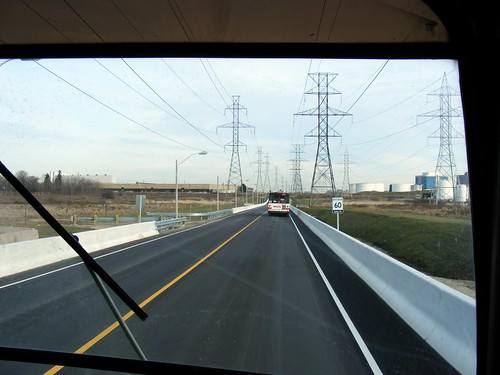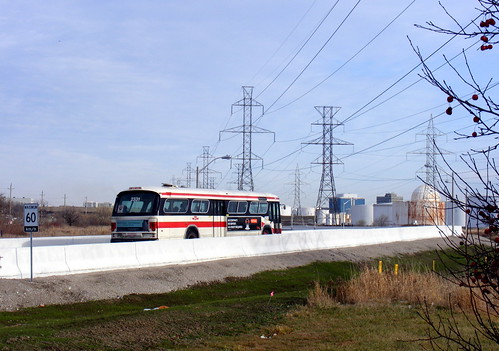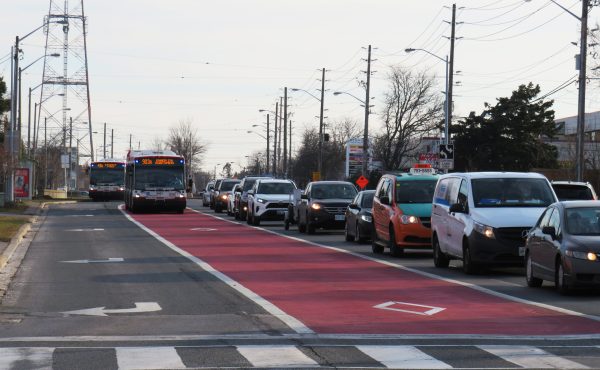2009 has proven to be a busy year for transit in the Greater Toronto Area. In Toronto alone, 2009 saw construction begin on the Spadina Subway Extension to York University and Vaughan Corporate Centre; as well as the grade separation of Sheppard Avenue, the first Transit City-related project, and the GO Transit Stouffville Line in Agincourt. The TTC also finally purchased new streetcars for the legacy street railway system, put forward a plan to improve the bus network, and opened up most of the new St. Clair streetcar right-of-way.
At the regional level, GO Transit has continued to plod along with upgrading its rail infrastructure, including the West Toronto diamond (a major irritant to nearby residents and businesses), the Union Station rail corridor, while extending its reach beyond the GTA into Peterborough, Niagara and Kitchener-Waterloo. And Queen Street in Brampton is all torn up for its own rapid bus system, rebranded from Acceleride to Züm.
But one major project flew under the radar in the midst of all these other projects and plans. On November 20, the York University busway opened, the GTA’s first major bus-only road. The new route passes through a hydro field between Dufferin and Keele and also includes bus-only lanes on Dufferin Street and a second internal bus-only road into the central campus north of Murray Ross Parkway. The cost borne by the three levels of government, according to a York University news article, was $37.8 million.
Construction began in April 2008 after several years of planning. A TTC Commission report dated April 27, 2009 anticipated a September opening in time for the new academic year, but typical of TTC projects, the road opened over two months late.
The busway is intended as a temporary measure of removing buses from regular traffic congestion that plagues the area near the York U campus. Route 196 York University Rocket uses the busway in its entirety; 117 Alness uses a small section of the busway as part of its loop, and the new 41E Keele Express uses part of the internal campus busway as well. The Viva Orange Line (Martingrove-Downsview) is expected to use the roadway as well, and GO Transit (where access to its main Steeprock Drive garage would reduce “deadhead” time) and Brampton Transit are welcome to use the roadway, according to the above mentioned report.
(Brampton Transit may use the busway starting in September 2010 as part of its Queen Street Züm route, possibly sharing or taking over the operations of Viva Orange).
Travel times of the 196 have improved significantly, at least on paper. Less buses are providing faster and more frequent service. A service summary from before the completion of the busway required 20 buses for the morning rush on the main 196A branch (Downsview station to York U), every 2 minutes, 15 seconds, with an average speed of 23.3 km/h. In November 2009, 16 buses, running every 2 minutes even, now have an average speed of 32.8 km/h.
Viva has yet to start using the roadway. When I visited, only TTC buses, Wheel-Trans vans and supervisory and transit enforcement cars were spotted on the route.
There are some issues with the new busway. At Alness and the internal busway and The Pond Road, sudden drops in grade force drivers to pass with care. Furthermore, some drivers claim that the timed saved with the new route is less than estimated, and that keeping up with the new schedule is tough. One driver felt the cost of the busway, particularly for the short period of time it will be used, was not worth the cost.
The bus-only lanes on Dufferin are former HOV lanes. The signs indicating their new status are not particularly large, and there appeared to be many drivers not abiding by the new law. Better signage and more enforcement would be useful here.
This is one case in which a bus-only road makes some sense, as the route provides rapid service between very limited points with very little in-between (the busway might qualify as Toronto’s ugliest road, running under hydro towers and between fuel tank farms). But busways are not very well suited to serving neighbourhoods. Systems like Viva have a different function, providing an attractive, higher-speed bus in mixed traffic or reserved lanes on a regular street. Indeed, the TTC should pursue this idea for its longer suburban and midtown corridors, particularly those not destined for light rail.






21 comments
This is pretty pathetic that the TTC has to subsidize other transit systems in order to get funding, the fact that Toronto’s downtown core is in desperate need of upgrades and new transit lines, yet they are building an extension into the 905. WTF! Does this make sense? And the fact that the TTC is so under funded that any kind of project that gets funding ends up getting huge attention and is considered a huge deal when in fact it’s not. This is a huge joke on the city and people of Toronto who will actually end up paying for this subway extension to the middle of no where.
There is also the issue of proper transit priority and transit signals. None of this left turn single occupancy vehicle going first, when it should be streetcars and buses get the first go after a red.
Toronto is still behind L.A. and Europe in using already available and designed transit signals. The current transit signals on St. Clair (and Spadina) are too similar to the regular traffic signals.
Toronto’s downtown core in desperate need of upgrades? … yeah maybe… but try living in the inner suburbs of Toronto and you will see where the upgrades are needed most.
Once the subway opens, hopefully this will become an ultra wide ultra smooth bike path
As a long time bicycle commuter to York, I am extremely disappointed that bicycles are not allowed on this road. I am not one to regularly disobey the law (at least in public) but it seems I have no choice http://www.youtube.com/watch?v=yOUR7ojH9jk as my only other real option is Finch http://www.youtube.com/watch?v=NebERZ-vfow
Yes, the fact that bikes have not been incorporated is a huge disappointment. I remember when the project was being discussed, bike lanes have been promised. I can’t link to a source because I heard it from the City Transportation Department people at a conference, as opposed to reading it somewhere, but it was said. It was, in fact, mentioned how there isn’t a very good way to get to York from the direction right now, and what a great thing to cyclists this project would be. Alas…
Perhaps off topic, but does anyone know why a subway connecting Sheppard and Downsview hasn’t been considered?
I used to go to York, using the subway then the 192 Rocket to get there and back home. I’m sure this bus is much better than before. I remember getting home: board the bus at York, which turns onto Keele and come to a halt in the traffic congestion. Sometimes it would take 45 minutes just to get to Downsview.
It’s too bad that bicycles -yet again- weren’t considered.
@Jason – it has been considered (most recently as part of the planning for increasing subway yard capacity on the YUS line).
It’s pretty costly because of the river crossing at Bathurst and the connection with the Spadina line. It would also impact the viability of the Finch West LRT. If the line was interlined with the YUS, the existing Sheppard stations would have to be completed to six car length.
@dws – cyclist breaks law because s/he “has” to. The sort of rationalisation bike couriers use for running red lights and endangering pedestrians downtown I suppose.
DWS, I noticed you rode the busway on your bike. Hint: it’s hard enough to see all CARS in the bus mirrors, and you’re only as wide as your shoulders. Hopefully you wear a flashing light.
Mark Dowling: Aren’t the Sheppard stations already completed to six car length? If I recall correctly, it’s just a matter of removing some temporary walls. Look at this photo of Leslie: http://transit.toronto.on.ca/images/subway-5119-15.jpg
The lack of enthusiasm behind this project is really quite depressing. This is the first true rapid transit project completed in a decade, with little reporting from the media, blogosphere, and even the TTC’s website.
Even more frustrating is how we are ignoring all the value of this bus rapid transit project. Once construction began, this thing was up in running in about two years, and for less than $7 million per kilometer! Just imagine if we were looking at busways for Transit City instread of tramways. We could have efficient and competitive transit all across Toronto and the GTA in half the time for the same money!
Also dws, this busway operates right through the territory I do my deliveries in. Yet I don’t drive along it, and instead battle through the traffic along Finch, Steeles, Alness, Keele, and Dufferin. Riding your bike or driving a car on a busway makes as much sense as doing the same along a railway. If you must use it, take the bus and use the bike racks provided.
Where was this when I was going to York U? (Hmm, when I started in ’77 there was no Spadina line, so getting there was a dismal long ride on the Keele 41D.)
But it’s not exactly an example of something that could be used widely.
The cheap cost of the York U busway comes down to a couple of things:
1) Half the “busway” was simply restriping a peak-time transit lane on Allen Road as a permanent transit-only lane
2) Putting a roadway through an empty no-mans-land is cheap, but not useful for local transit
3) Zippo passenger stop, station, or transfer facilities, not even a new bus stop sign was required
The busway works because Allen Road is already there, and is a fast near-expressway with comparatively few traffic lights and almost no driveways or side streets. And while the hydro ROW is fine for getting to York U, it’s not a suitable alignment for any Finch W transit scheme, LRT or busway. (This has been hashed out repeatedly on Steve Munro’s website stevemunro.ca; I will not repeat it here.)
There are few places where a busway could substitute for LRT, for example on Eglinton west of Jane a bus lane could be placed off in the empty expressway ROW. (Oddly, the TTC does not want to do this side-of-road arrangement for LRT.) However, the crowded narrow part of Eglinton between Black Creek and Laird needs underground service, and diesel buses won’t cut it there: back to LRT.
For many other Transit City routes, a middle-of-the-road ROW is required, because of all the side streets and strip mall driveways. Once you have a middle-of-the-road ROW, it doesn’t cost much more to install LRT. And LRT carries more per vehicle, saving on operator costs.
Anyone who has ridden on a road with a “transit-only” curb lane, for example Don Mills Road, understands that there’s no way to implement fast service in a reserved curb lane. So your transit vehicles need to be in the centre, and now you have all sorts of stop infrastructre to build.
None of which was required for the York U busway. To do a “real” busway for a Transit City route is going to be a whole lot more expensive than the quoted $7million/km (however that was derived). And completely impossible in underground sections.
TTC has stated an intention to use the busway for yet-to-be determined routes after the Spadina subway extension opens. York U. is likely leery of this, but I’m not aware whether the campus portion of the ROW is included in TTC plans.
Mark Dowling: As I drive down the 400 in my little Honda Fit at 115 flying by all the other cars on the road (not), I am shocked that the OPP are not giving out tickets to all those flagrant law breakers endangering the safety of others.
@dws – you mistake me. I have no problem with photo radar.
Why limit to speed to 60 km/h? In Ottawa, the speed limit on most of the Transitway is setted between 70 and 90 km/h. Since only TTC vehicles use the York busway, surely they could be permitted to go at 70 or even 80 km/h? Then, you would be reducing travel time even more.
The exclusive busway portion between Dufferin and Keele is less than 2 km. At 60 km/hr, that is less than two minutes. So raising the speed limit would not make any significant difference.
Funny in the picture to watch a 1960s era bus trundle along the transitway – says a lot about the state of transit in TO, and Canada generally.
Not “Less buses are providing faster…” Fewer buses.
Bubba, subway extension to the middle of nowhere? Really? The subway would service Vaughan, one of the fastest growing municipalities in Canada! Vaughan doubled it’s population since 1991! It has a 9.3% annual growth rate, compared to Toronto’s measly 0.8%. Who needs new transit infrastructure? VAUGHAN